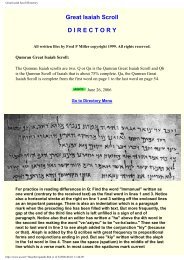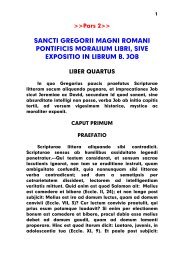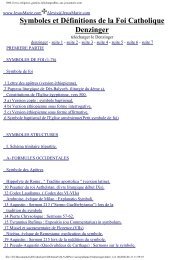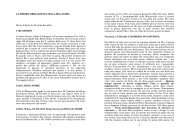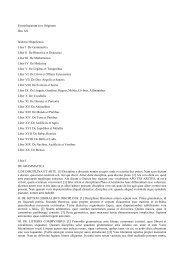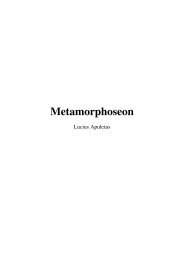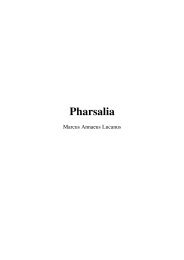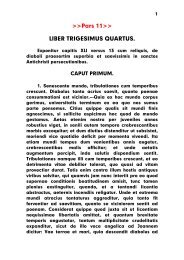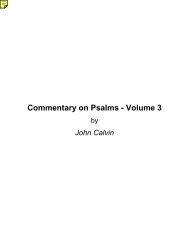The Dolorous Passion of Our Lord Jesus Christ. - documenta ...
The Dolorous Passion of Our Lord Jesus Christ. - documenta ...
The Dolorous Passion of Our Lord Jesus Christ. - documenta ...
Create successful ePaper yourself
Turn your PDF publications into a flip-book with our unique Google optimized e-Paper software.
<strong>The</strong> <strong>Dolorous</strong> <strong>Passion</strong> <strong>of</strong> <strong>Our</strong> <strong>Lord</strong> <strong>Jesus</strong> <strong>Christ</strong>.Anne Catherine Emmerichto endure, the more so, as these phenomena displayed themselves in the most unusual and astonishingmanner. She heard everything that was said against her, even when the speakers were at one end<strong>of</strong> the convent and she at the other, and her heart was most deeply wounded as if by poisonedarrows. Yet she bore all patiently and lovingly without showing that she knew what was said <strong>of</strong>her. More than once charity impelled her to cast herself at the feet <strong>of</strong> some nun who was particularlyprejudiced against her, and ask her pardon with tears. <strong>The</strong>n, she was suspected <strong>of</strong> listening at thedoors, for the private feelings <strong>of</strong> dislike entertained against her became known, no one knew how,and the nuns felt uncomfortable and uneasy, in spite <strong>of</strong> themselves, when in her company.23Whenever the rule (the minutest point <strong>of</strong> which was Sacred in her eyes) was neglected in the slightestdegree, she beheld in spirit each infringement, and at times was inspired to fly to the spot wherethe rule was being broken by some infringement <strong>of</strong> the vow <strong>of</strong> poverty, or disregard <strong>of</strong> the hours<strong>of</strong> silence, and she would then repeat suitable passages from the rule, without having ever learnedthem. She thus became an object <strong>of</strong> aversion to all those religious who broke the rule; and hersudden appearances among them had almost the effect <strong>of</strong> apparitions. God had bestowed upon herthe gift <strong>of</strong> tears to so great an extent, that she <strong>of</strong>ten passed whole hours in the church weeping overthe sins and ingratitude <strong>of</strong> men, the sufferings <strong>of</strong> the Church, the imperfections <strong>of</strong> the community,and her own faults. But these tears <strong>of</strong> sublime sorrow could be understood by none but God, beforewhom she shed them, and men attributed them to mere caprice, a spirit <strong>of</strong> discontent, or some othersimilar cause. Her confessor had enjoined that she should receive the holy communion morefrequently than the other nuns, because, so ardently did she hunger after the bread <strong>of</strong> angels, thatshe had been more than once near dying. <strong>The</strong>se heavenly sentiments awakened feelings <strong>of</strong> jealousyin her sisters, who sometimes even accused her <strong>of</strong> hypocrisy.<strong>The</strong> favour which had been shown her in her admittance into the convent, in spite <strong>of</strong> her poverty,was also made a subject <strong>of</strong> reproach. <strong>The</strong> thought <strong>of</strong> being thus an occasion <strong>of</strong> sin to others wasmost painful to her, and she continually besought God to permit her to bear herself the penalty <strong>of</strong>this want <strong>of</strong> charity in her regard. About <strong>Christ</strong>mas, <strong>of</strong> the year 1802, she had a very severe illness,which began by a violent pain about her heart.This pain did not leave her even when she was cured, and she bore it in silence until the year 1812,when the mark <strong>of</strong> a cross was imprinted exteriorly in the same place, as we shall relate further on.Her weakness and delicate health caused her to be looked upon more as burdensome, than usefulto the community; and this, <strong>of</strong> course, told against her in all ways, yet she was never weary <strong>of</strong>working and serving the others, nor was she ever so happy as at this period <strong>of</strong> her life—spent inprivations and sufferings <strong>of</strong> every description.On the 13th <strong>of</strong> November 1803, at the age <strong>of</strong> twenty-nine, she pronounced her solemn vows, andbecame the spouse <strong>of</strong> <strong>Jesus</strong> <strong>Christ</strong>, in the Convent <strong>of</strong> Agnetenberg, at Dulmen. ‘When I hadpronounced my vows,’ she says, ‘my relations were again extremely kind to me. My father and myeldest brother brought me two pieces <strong>of</strong> cloth. My father, a good, but stem man, and who had beenmuch averse to my entering the convent, had told me, when we parted, that he would willingly pay12



